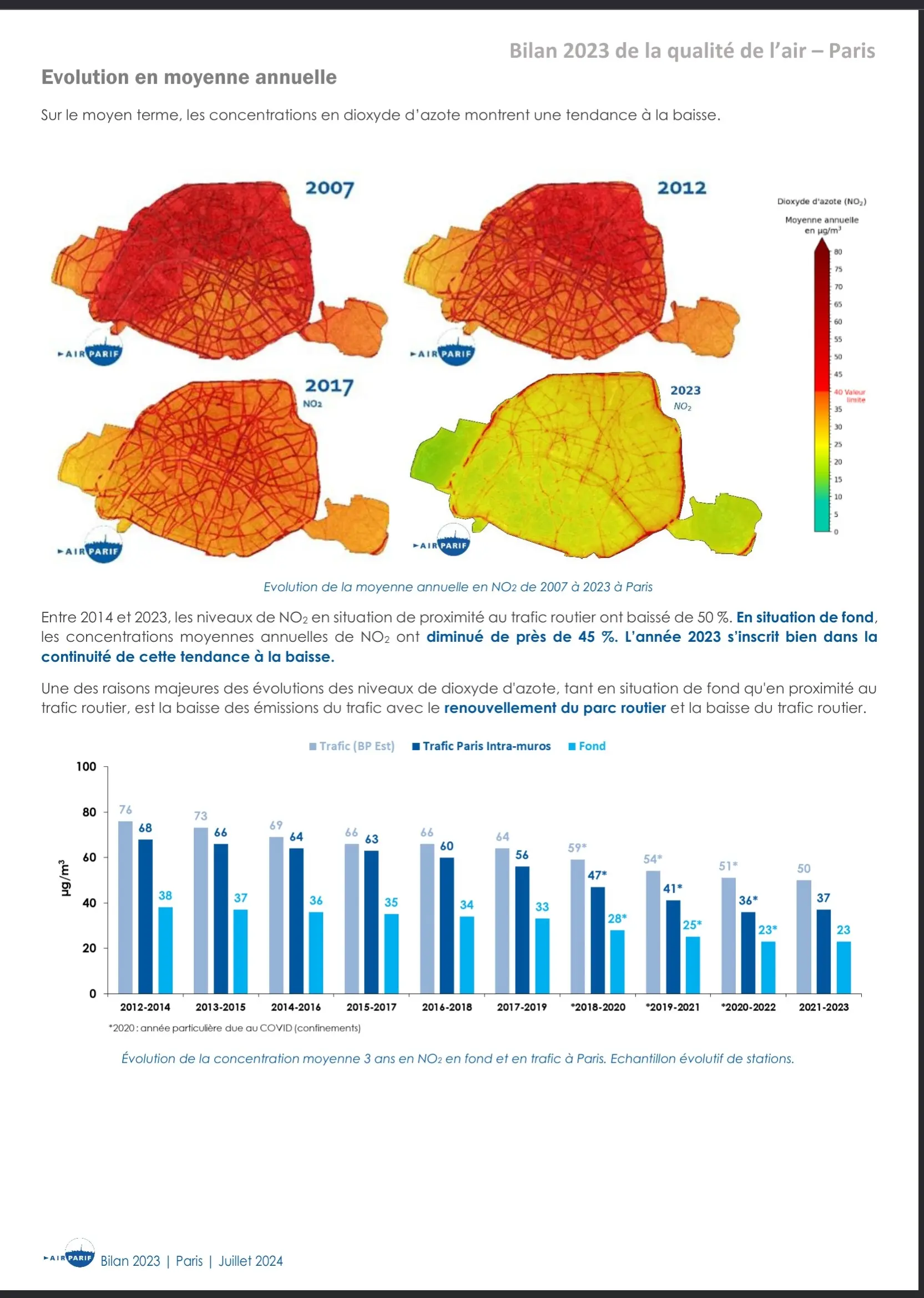- cross-posted to:
- fuckcars@lemmy.world
- cross-posted to:
- fuckcars@lemmy.world
Yep, but you still live or work in Paris.
Only so much you can do
Anyone else bothered by the sudden change in scale in the last image? It’s way zoomed in compared to the first 3.
Looks similar to this

https://www.airparif.fr/sites/default/files/document_publication/Bilan_QA_75_2023_1.pdf
I don’t love it either but the scale does look the same across the four.
If you look at the vein(?) on the north side of the loop, there’s a part that goes straight north and then east, with a break in the north leg. Makes it a lot more clear that it was zoomed in.
Two different scales at play. The geographic scale clearly changes in the last image, but thankfully the measurement scale (as indicated by the color bar below each picture) stays constant, which would be much more egregious in terms of making the image misleading if it did not.
Oh. Yeah, definitely. That would be way worse.
Anecdata. I lived there for much of that period. The change in air quality itself was real but too subtle to be noticeable. But the change in the amount of car traffic in Paris has been very noticeable, and very impressive.
Some context. The municipal setup gives residents of Paris proper (the 2 million people within the ring road in the image) a lot of influence over the whole Paris region. And 2/3 of those central residents do not own cars! Meanwhile, as in any city, much of the car traffic is generated by suburban drivers. Some of these drivers don’t have good transit options, but most of them do. Paris has one of the world’s densest transit systems, and that includes the suburbs. Moreover, the suburbanites have always denied the trade-off between housing space and convenience. Yes, the people in central Paris tend to be a bit richer, but they’ve also accepted the sacrifice of living in small apartments and foregoing private transport. One study found that the average resident of central Paris walks around 2km per day.
So those central Paris residents voted, again and again, to take space away from cars and to give it to bike lanes and sidewalks and parks instead. The local green party has been instrumental, it attracts 10 or 15% of the vote and is a part of the city’s coalition government. I was one of those voters. This is the result. It’s been positive for the whole city and it’s a genuine good news story.
Walks 2km a day? That doesn’t seem like much… or is it a subtle flex based on how accessible everything is by foot?
2km on the sidewalk. If correct (anecdotally I’d say it is) then that is very unusual and implies (a) good sidewalks and (b) dense transit. In most of the world, either transit is non-existent or cities are completely unwalkable and people use vehicles to go 100m. You’re left with a few places like Paris and Tokyo.
IIRC, paris put into play car taxes similar to what NYC just put in along with outright bans in some areas.
Every city of moderate size should do the same. Having so much space allocated for cars is just insane and provides nothing but cancer to the general citizenry.
Same in Oslo.
The people who live in the city, does not want cars in the city.
And the same small parties have been getting though their agenda because the larger parties does not have majority votes. So they have to include these small green parties.
I am new to Copenhagen and have heard that it’s been a pretty consistent growth in that direction. As someone who lived in the US for years, it feels really refreshing here because of it
How popular are ebikes? I think they can solve a lot.
There are lots of bikes of all kinds. All this has happened in the last decade or so. There have been cycle lanes for decades but they were mostly empty. Then the pace of building picked up, and then the pandemic seemed to be a tipping point.
The way it works is that inside the ring is Paris and outside isn’t Paris. So only some have a say in how the city is run.
Eventually, Paris will probably grow again. But for now, that’s how it is.
That’s a bit of a simplification. There is also an elected government for the Paris region. It just has fewer powers than most big-city governments. So yes, suburbanites get an unusually small say in what happens in the city center. But the inverse is true too - central residents get less of a say in what happens in the suburbs. The issue is that, like in any city, much of car traffic across the center comes from the suburban periphery, where people own cars and use them. That is clearly an injustice for the central residents, who have to suffer the externalities of those cars. In this case the quirky institutional setup allowed those residents to put their foot down and say no, so that is unsurprisingly what they did.
True, I simplified because a lot of people outside of France don’t know how large Paris is.
In a world that is burning it is refreshing to see things like this!
The burning is still happening. Just not inside Paris
Car lovers: but my emissions :'(
I wonder whether they have noise pollution meters. that would be interesting to see the difference.
Edit: there is! https://carto.bruitparif.fr/ But only until 2022?
2017

2022

2022 was much quieter, but that was also during COVID. I wish they had something for 2023 and 2024
Fuck cars.
80% of the noise over 75dB in a French city is two stroke petrol scooters going “baaaaaaababababbaaaaaaa” at 3 in the morning.
Ugh those need to be banned and replaced with electric scooters. Some place in Asia did that and the air quality went up dramatically.
My eyes are burned into my head due to someone using a pie chart on these data…
Car lover here. Fortunately we have things like DEF injection nowdays to keep NOx emissions down while still enjoying our cars! It is however unfortunate that many people remove those systems because of perceived unreliability.
Still, soon as I can afford it, I’ll be moving to electric myself. Electric cars do cause more noise at any real speed though, as tire noise overtakes engine noise at 30-40 km/h in my experience, and EVs are a fair bit heavier. But the grid is a lot cleaner nowadays than burning diesel fuel.
deleted by creator
Taking inspiration from a demonic sigil, in this case odegra, to cause a circle of low-level evil to be produced around Paris by the motorists, and making it incredibly frustrating to drive on, seems hardly something to be happy about

Mate, you’ve gotta put down the glue, it’s rotting your brain.
Good Omens reference?
Zero context. The first 3 could be peek traffic hours on a day with high heat and no wind. And the fourth a Sunday during some national event that people watched on TV, while a storm blows away most of the pollution.
Or they could be completely fake, as there is no source stated.A complete lack of context it’s a pretty worthless, very low effort post IMO.
Edit:
Thanks for the downvotes, because linking the source would have been Soooo difficult. /sThe french text says it is average levels over a full year. Also, the source is listed in the image.
That’s how fakenews are made, “look it up” but most don’t because trusting you is more convenient.
No it says source, but the following text is ineligible.
It says Air Parif / ©APUR
 Air Parif
Air Parif
Reading the annotations on each of the plots, these are all average NOx concentrations of the labelled year, not point measurements - as you are insinuating. Furthermore, the color scales match up too. (edit) Do note: the more recent plot is zoomed in though and scales are much less clear!
I think it is fair to say that recent policy changes, like rejecting private vehicles from the center and promoting active transportation work. Though aftereffects of COVID (work-from-home) may be a contributor too.
Since the graphic measures NOx emissions, this is mostly about diesel vehicles, older than Euro 5 or Euro 6 specifically. Also, while researching this I found out that starting this month, all diesel vehicles are banned in Paris.
There were also the Olympics, and the French put in a lot of effort to make Paris as appealing as possible.
We’re looking at 15 years of data encapsulated in 4 annual averages. If they put in that kind of effort for the sake of the Olympics, well, good on them for playing the long game.
Reading the annotations on each of the plots
Yeah about that, the text is incredibly smeared, and it’s in french. Pardon me for not knowing french. 😜
not point measurements - as you are insinuating.
Which would have been about equally obvious to many if the text was in Swahili!! No matter how clear.
Funny how people reward such lazy posting, where adding a link to the source could have cleared it up easy.
Pictures could be completely fake for all we know without a source.While not understanding French is understandable, Google Translate and other tools can help with that nowadays. You ought to be careful when levying critique on a post, and ensure it is valid. Your mistake was noticed by me in this case, but this could very well be the misinformation against which you caution.
Regarding the laziness in sourcing: I agree that sourcing is not properly provided here. A reverse image search surfaces that many of the plots are available here and refers to the source also stated on the image (Apur), which seems to be an entity with regularly does analyses regarding mobility in Paris, which has analysed these topics before. Whether you trust this source is still up to you, but the source is not simply an anonymous person on the internet.
So what you say is, that I should put A LOT OF EFFORT into figuring out the validity, because OP put ZERO EFFORT into it, and just research the entire thing myself? Typing manually what OP could have just copy-pasted. That’s INSANE!
If OP want’s to show something, and maybe make a point, why not include the link where he got the picture from? It’s a simple copy-paste! It’s insane that people find this to be OK, when it’s basically not much more than noise without the source.
If you don’t want to spend the time, you could have simply critiqued the image for being hard to read and interpret, as you are doing now - and requested they provide the source of the image (or the data). That would have been perfectly valid - as this image has seemingly gone through a lot of jpeg-ification and screeshotting, making captions and labels hard to read.
Yeah I could, I guess I was a bit annoyed by the laziness of the post.
And I maintain it’s bad style to not include a simple link to where “he” got the photo.
As someone else mentioned, that’s how fake news are often spread.
I agree with your basic point, about not automatically trusting sources.
https://www.paris.fr/pages/etat-des-lieux-de-la-qualite-de-l-air-a-paris-7101 This was on the crosspost
That do be true tbh, however, Paris have been, at least in the past few years, quite invested in fighting cars, so I’m inclined to think that this graphic is true.
We should be doing a wellness check. Clearly the French have stopped smoking. And knowing the French get revolution-y when agitated: … should we be concerned?
I feel like that has more to do with WFH after the pandemic than anything but still good news none the less
Nope, this is what happens when you replace parking with bike lanes.
The bsky post I took this from suggests that a lot of this is due to Paris’s mayor: https://bsky.app/profile/brenttoderian.bsky.social/post/3lfvj5yo6fk2l
Yep, improving Paris’ air quality has been a major focus for her for a long while. A huge number of roads have been replaced by cycle paths/public transport only, the speed limit throughout most of the city has been reduced from 50km/h to 30km/h, street parking spots have been reduced drastically, and certain older cars can’t are limited. It’s going to improve further given the périphérique speed has also been reduced (major traffic artery around the city), and the centre arrondissements are now being restricted for vehicles. Vehicle drivers are not too happy, but it does make a big difference for quality of life when you live and work in the city.
They’re also building mass transit with trams and metro lines like crazy. Paris is knocking it out of the park as a developed city should be.
Yes. Of course wider changes like WFH and pandemic have affected things but specific policy choices have led to those trends being supported and reinforced in order to produce better air quality outcomes. Both those trends are present in lots of cities without this drastic impact.







